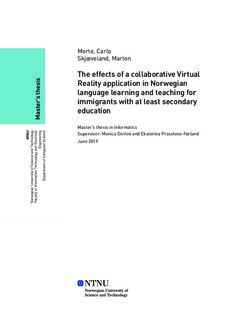| dc.contributor.advisor | Divitini, Monica | |
| dc.contributor.advisor | Prasolova-Førland, Ekaterina | |
| dc.contributor.author | Morte, Carlo | |
| dc.contributor.author | Skjæveland, Marton | |
| dc.date.accessioned | 2019-11-06T15:03:36Z | |
| dc.date.available | 2019-11-06T15:03:36Z | |
| dc.date.issued | 2019 | |
| dc.identifier.uri | http://hdl.handle.net/11250/2627019 | |
| dc.description.abstract | Denne studien har et mål om å se effektene av Virtual Reality for norskundervisning ved bruk av samhandling. Brukergruppen er immigranter som har videregående utdanning eller mer, i tillegg til norsklærere. Innvandring og integrering er en viktig prosess i Norge, der deltakelse på arbeidsmarkedet er sett på som essensielt for integrasjon. Mens kompetanse i det norske språket og kjennskap til norsk kultur er viktige forutsetninger for å komme inn i arbeidsmarkedet og utdanningssystemet. Samtidig har Virtual Reality funnet suksess og popularitet innen opplæring og utdanning.
Med ``design and creation'' forskningsmetoden ble en Virtual Reality-applikasjon utviklet ved hjelp av rammeverket Scrum og brukersentrert design. Studier har funnet at en konstruktivistisk tilnærming fungerer best med Virtual Reality. Sosialkonstruktivisme og erfaringsbasert læring har derfor vært inspirasjon for læringsinnholdet. De fleste relaterte verk inkluderer ikke læreren, og deres rolle i en slik applikasjon er ukjent. For å svare på dette, samarbeidet vi tett med lærerne under utviklingen. Dette resulterte i en applikasjon som satte brukerne i et virtuelt miljø skreddersydd av en lærer, der elevene kan samarbeide med å fullføre instruksjonsbaserte oppgaver.
Resultatene viser at det er interesse og potensial i applikasjonen. Det var tegn på en sterk følelse av innlevelse, økt motivasjon og endring i det sosiale hierarkiet mellom lærere og studenter. På en annen side, følte noen deltakere at det var vanskeligere å holde seg fokusert sammenlignet med et vanlig klasserom og læringsutbytte kunne ikke måles tilstrekkelig. Videre arbeid bør undersøke mer grundige evalueringer av effekten av det virtuelle miljøet, kommunikasjon gjennom den virtuelle avataren og applikasjonens læringsutbytte. | |
| dc.description.abstract | This study aims to see the effects of collaborative Virtual Reality on Norwegian language teaching and learning. The focus group is immigrants with at least secondary education and Norwegian language teachers. Immigration and integration is an important process in Norway, where participation in the job market is seen as a vital route for integration. At the same time, competency in the Norwegian language and familiarity about the Norwegian culture are important preconditions to enter the job market and education system. At the same time, Virtual reality has found success and has gained popularity within training and education.
With the design and creation research method, a Virtual Reality application was developed using the Scrum agile framework and user-centred design. Studies have found that a constructivist approach works best with Virtual Reality. Social-constructivism and experiential learning has therefore been inspirations for the learning content. Most of the related works does not include the teacher, and their role in such an application is unknown. To answer this, we cooperated closely with teachers during development. This resulted in an application immersing users in a virtual environment customised by a teacher, where students can collaborate in completing task-based instructions.
The findings show that there is interest and potential in the application. There were signs of a strong feeling of immersion, increased motivation and a change in the social hierarchy between teachers and students. On the other hand, some participants felt it was more difficult to stay focused compared to a regular classroom and learning outcome could not be measured sufficiently. Further work should look into more thorough evaluations on the effects of the virtual environment, communication through the virtual avatar and the learning outcome from the application. | |
| dc.language | eng | |
| dc.publisher | NTNU | |
| dc.title | The effects of a collaborative Virtual Reality application in Norwegian language learning and teaching for immigrants with at least secondary education | |
| dc.type | Master thesis | |
